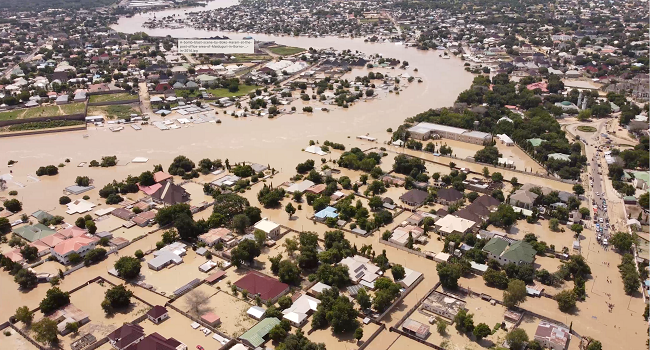The Federal Government, through the Nigeria Hydrological Services Agency (NIHSA), announced on Thursday that water from the Lagdo Dam in Cameroon has been released into Nigeria’s River Niger and River Benue, located in the North Central region.
The Agency urged Nigerians living in flood-prone areas to relocate immediately to safer locations in anticipation of the floods that typically follow the release of water from the Lagdo Dam.
NIHSA Director-General, Umar Mohammed, issued this warning during an appearance on Channels Television’s *The Morning Brief* program on Thursday.
Mohammed explained that the Agency had met with Cameroonian authorities and agreed that the water from the Lagdo Dam would be released “intermittently” to allow the River Benue and River Niger to manage the water volume and minimize flooding risks in 11 vulnerable states.
“The situation is that water from Cameroon’s Lagdo Dam has been released already since yesterday (Wednesday) and there is an agreement that the water should be released in phases,” said Mohammed, who was represented on the programme by the Agency’s Director of Operations and Hydrology, Femi Bejide.
On Tuesday, the Federal Government alerted Nigerians about the Cameroonian authorities’ plan to release water from the Lagdo Dam.
NIHSA identified the flood-prone states as Adamawa, Taraba, Benue, Nasarawa, Kogi, Edo, Delta, Anambra, Bayelsa, Cross River, and Rivers.
The NIHSA Director-General assured that the situation is currently stable, with water flow from the Lagdo Dam being regulated, although water levels are gradually rising.
He emphasized that preventing flooding is a collective responsibility, noting that previous releases from the Lagdo Dam have consistently caused flooding in Nigeria.
“Everybody has their part to play; as the Federal Government is doing its part, our agency is doing its part, NEMA is prepared, individuals should also have to do their part. They have to move from the floodplain.
“Houses also, have their drainages, they have to clean and clear their drainages. Water will find its way so the waterways should be cleared, and the drainages should be cleared to allow water to move. That is the responsibility of everybody.
“Look at your house, if your house is at the flood plane, please move please move from the flood plane, it is an appeal,” the NIHSA boss stated.
FG To Build Five Buffer Dams
Mohammed said a report has been submitted to the Presidency, on the way forward noting that some of the dams in Nigeria have to be de-silted.
“What has to be done also is that there’s a report that has been submitted to the Presidency. We have to have buffer dams and five have been proposed and the Federal Government is looking at that already,” he said.
“But in the interim, some of our dams have to be de-silted, the tributaries of River Niger and Benue have to be expanded.
“I learnt that there is a little issue with the design and they are trying to amend the design. I believe that in the next two to three years that would have been put in place.”
The release of water from the Lagdo Dam follows the recent overflow of the Alau Dam, which claimed over 30 lives and destroyed thousands of homes in Maiduguri, the capital of Borno State.
In 2022, severe flooding affected multiple states, resulting in 665 deaths, displacing 2,437,411 people, and impacting a total of 4,476,867 individuals, according to the National Emergency Management Agency (NEMA).
In 2023, floods affected 159,157 people, claimed 28 lives, and displaced 48,168 individuals, with the release of water from the Lagdo Dam contributing to some of these incidents.
For 2024, NEMA reported that between April and September, flooding affected 1,048,312 individuals, displaced 625,239, and caused 259 fatalities.



